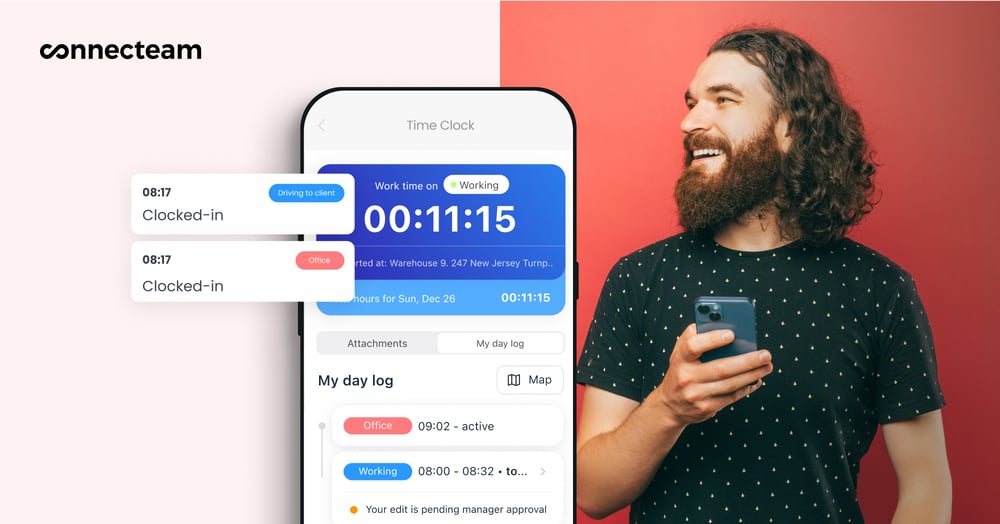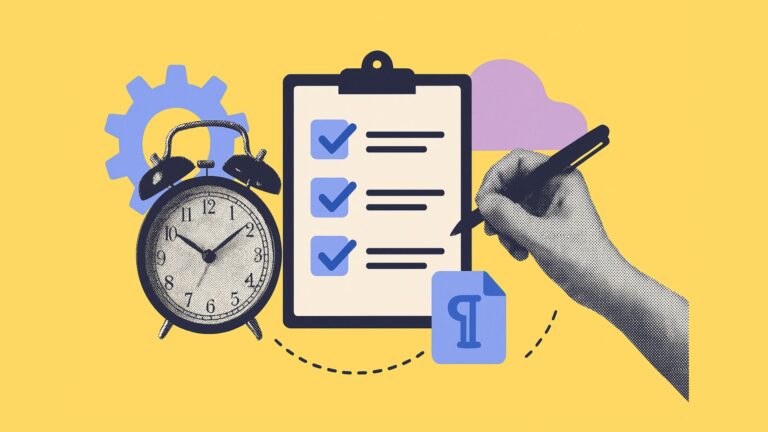Timekeeping doesn’t have to be a pain. The right policy can keep your team on time and your business covered.
It seems easy enough: employees show up, clock in, work, and clock out. But what happens when someone starts work before their shift, skips a lunch break, or picks up unapproved overtime?
Without a clear time-tracking policy, you could be dealing with wage disputes, avoidable audits, and costly compliance violations.
Timekeeping systems like timesheets, punch clocks, and mobile apps, help enforce your policy and keep tracking fair, consistent, and compliant. But where do you start, and what do you need to include to create a great timekeeping policy?
In this article, we review the ins and outs of timekeeping and provide a free template for writing your own policy.
What is a Timekeeping Policy?
A timekeeping policy is a written set of rules that outlines how your employees are expected to accurately record their work hours. It typically covers the right procedures for clocking in and out, taking breaks, handling missed punches, and reporting overtime.
Having an established policy sets expectations for both employees and employers. It ensures that working hours are tracked accurately and your staff is paid fairly for the time they worked.
A good timekeeping policy should aim to do two things:
- Support legal compliance by outlining how work hours must be tracked to ensure that employees are paid correctly.
- Set clear expectations so your employees know how to record their time and avoid mistakes that could lead to payment errors or legal trouble.
Do I Need a Timekeeping Policy?
You’re not required by law to have a written timekeeping policy—but if you manage a team, having one is a smart move.
Here’s why: US labor laws, specifically the Fair Labor Standards Act (FLSA), require you to track and maintain accurate records of hours worked and wages paid—especially for non-exempt employees. That includes regular hours, overtime, and any deductions or additions to pay.
Under FLSA, non-exempt employees must be paid for all hours worked, including overtime for anything over 40 hours in a workweek. Exempt employees—usually salaried—aren’t entitled to overtime, but that depends on their job duties and salary level, not just their pay type.
While the FLSA doesn’t specify how you should track time, it does require you to maintain accurate and complete records. At a minimum, you need to track:
- When the employee’s workweek starts (day and time)
- Hours worked each day and total hours each workweek
- How the employee is paid (hourly, salaried, per job, etc)
- Regular hourly rate
- Total straight-time and overtime earnings
- All additions or deductions (bonuses, taxes, benefits)
- Total wages paid for each pay period
- When the employee was paid and for which dates
Think of these as your legal must-haves—and a great starting point for what to include in your timekeeping policy.
What Should I Include in My Policy?
The FLSA’s requirements provide a great guide of what to cover in your timekeeping policy, but there’s more to consider.
A strong policy leaves little room for confusion. It should clearly explain how time is tracked, who’s responsible for what, and how to handle issues when they come up.
Here are the key elements to include:
Time Clock Procedures: How and When to Clock In and Out
Be clear about how your employees are expected to track their time—whether it’s with a punch card, paper timesheet, or a time clock app.
Make sure your policy explains exactly when to clock in and out. For example, employees should clock in when their shift starts—not when they arrive or begin settling in. Similarly, they should only clock out when their shift ends and all work is done.
If someone forgets to clock in or out, your policy should outline what steps they should take, who to notify, and how the issue will be fixed.
What Counts as Paid Time vs. Unpaid Time
Define what is considered paid time and what is not. Paid time includes anything work-related— like setting up before a shift, staying late to finish tasks, or answering work messages after hours.
Unpaid time usually involves meal breaks or off-duty periods when an employee isn’t doing work-related tasks. Make these distinctions clear in your policy to avoid any misunderstandings.
Break Rules
Your policy should explain when breaks happen, how long they last, whether those breaks are paid or unpaid, and whether employees need to clock in and out for them.
In general, short rest breaks are paid, while longer meal breaks are unpaid. Check federal and state laws to make sure your break policy is compliant.
Overtime Procedures
Even though overtime is defined under the FLSA (over 40 hours in a workweek for non-exempt employees), it’s still important to include it in your policy.
Clarify how overtime works in your company, whether pre-approval is required, and what happens if an employee works overtime without approval. Just remember: even if overtime wasn’t authorized, it still has to be paid.
How to Make Timesheet Corrections
Mistakes happen. Someone forgets to clock in or notices an error in their hours. Your policy should explain how to report issues, and who to speak to make corrections.
Remember: Fixing timekeeping errors early helps avoid payroll issues down the line.
Tools like Connecteam’s Online Timesheets make finding and fixing errors easy. Get notified about any discrepancies and approve timesheets in bulk or individually before sending them to payroll.
Manager Responsibilities
Make clear what’s expected from managers. In most cases, they’re responsible for reviewing and approving timesheets, making sure hours are accurate, and flagging any issues before payroll is processed.
How Do I Create a Timekeeping Policy?
Creating a timekeeping policy doesn’t need to be complicated. The key is to clearly define your expectations and cover all the essentials.
To help you get started, we created a simple, customizable template (below) you can use as a starting point and adapt to fit your business.
Try it out:
At , maintaining accurate time records is essential for payroll accuracy, legal compliance, and operational efficiency. Employees are required to record their work hours using the .
This policy outlines expectations for time reporting and provides guidance for all employees and managers to ensure compliance with wage and hour laws.
Standard Work Hours
Standard work hours for are:
- Start Time:
- End Time:
Employees are expected to work these hours unless otherwise approved by a direct manager.
Workweek Definition
The official workweek at begins on and ends on . Overtime hours and total weekly hours are calculated based on this defined workweek.
Time Clock Procedures
Employees must clock in at the start of their shift and clock out at the end of their shift using . This includes:
- Clocking in no earlier than
- Clocking out at the end of their shift after all job duties are complete.
- All breaks (including meals) must be tracked according to .
If an employee neglects to clock in or out, they must notify as soon as possible so corrections can be made.
Accurate Time Reporting
- Actual start and end times for their shifts
- All paid and unpaid breaks
- Any approved time worked outside standard work hours
Overtime Policy
Employees must receive advance approval from to work more than in a single workweek. Unauthorized overtime will be paid but may result in disciplinary action.
- Staying late
- Arriving early
- Working through unpaid breaks
Manager Responsibilities
- Reviewing and approving employee timesheets by .
- Ensuring compliance with the timekeeping policy.
- Addressing any time discrepancies promptly and fairly.
Acknowledgment
I acknowledge that I have read and understand the timekeeping policy outlined above. I confirm my understanding and agree to follow the procedures described.
Employee Name:
Date:
Signature: _______________________________
How to Get the Most of Your Timekeeping Policy
Creating a timekeeping policy is a great first step—but for it to actually work, your team needs to understand it, follow it, and use it every day.
Here’s how to make your time-tracking policy stick:
Enforce it (consistently!)
A policy only works if it’s applied across the board. Hold everyone—new hires, long-time employees, and managers—to the same standard. If someone regularly skips clocking in or forgets to log their hours, address it early and fairly. You don’t have to be strict, but you do need to be clear and consistent.
Communicate it clearly
Don’t just stick your policy in a binder and hope people read it. Go over it with your team and make it a key part of onboarding for new employees. It’s just as important to explain why accurate time tracking matters as it is to explain the rules.
With Connecteam’s Updates feature, let your team know about important policies with pinned updates, notifications, and reminders. Track who has seen an update to make sure nothing is missed by requiring employees to confirm that they’ve viewed the update.
Make it easy to find
Your policy is only helpful if your employees know where to find it. Keep it accessible by adding it to your employee handbook, onboarding materials, and internal systems like your company app or online knowledge base. When employees can easily find the policy, they’re more likely to follow it—and avoid costly mistakes.
Did You Know?
You can keep all your company documents in one app? With Connecteam’s knowledge center, employees can easily access procedures and useful information. You can even track who has read what to make sure everyone is on the same page.
Use Connecteam to do the heavy lifting
Manual timekeeping can lead to missed hours and payroll mistakes. The right time-tracking software can serve as a digital time clock, track breaks, calculate hours, send reminders if an employee forgets to clock in or out. With employee management apps like Connecteam, it’s easier to spot issues with digital timesheets and check records if there’s ever a dispute. Look for a tool that works for your team and integrates with your payroll system.
This Might Interest You
We made a list of the best clock-in clock-out apps to simplify time tracking for your business.
Frequently Asked Questions
Are employers required to track hours worked by employees?
Yes, under the Fair Labor Standards Act (FLSA), employers must keep accurate records of hours worked for non-exempt employees for a minimum of 3 years.
How do I prevent time theft in the workplace?
Clear timekeeping policies, real-time tracking, manager oversight, and tools with GPS and geofencing features can reduce time theft and buddy punching.
Do salaried employees need to track time?
It depends. Exempt (salaried) employees aren’t required to track hours under federal law, but some employers still track for productivity or PTO purposes. Non-exempt salaried employees must track time.
The Bottom Line on Timekeeping Policies
A timekeeping policy isn’t just “nice to have”—it’s a key part of running a compliant, productive, and fair business. When time tracking is clear, consistent, and actually followed, everyone wins. Employees know what’s expected of them, payroll runs smoothly, and your business stays protected.
But just having a policy on paper isn’t enough. To make it really work, you need to communicate the policy clearly, make it easy to access, and use the right tools to support it.

That’s where Connecteam comes in.
Connecteam’s all-in-one time tracking app makes it easy to stick to your policy. From digital time clocks and GPS tracking to break logging, automatic reminders, and manager approvals—everything you need is built right in.
With a great policy and the right tool in place, timekeeping becomes simple, accurate, and stress-free.


